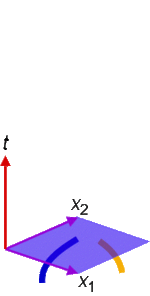Exchange operator
In quantum mechanics, the exchange operator  is a quantum mechanical operator that acts on states in Fock space. The exchange operator acts by switching the labels on any two identical particles described by the joint position quantum state
is a quantum mechanical operator that acts on states in Fock space. The exchange operator acts by switching the labels on any two identical particles described by the joint position quantum state  . Since the particles are identical, the notion of exchange symmetry requires that the exchange operator be unitary.
. Since the particles are identical, the notion of exchange symmetry requires that the exchange operator be unitary.
Construction


In three or higher dimensions, the exchange operator can represent a literal exchange of the positions of the pair of particles by motion of the particles in an adiabatic process, with all other particles held fixed. Such motion is often not carried out in practice. Rather, the operation is treated as a "what if" similar to a parity inversion or time reversal operation. Consider two repeated operations of such a particle exchange:
Therefore  is not only unitary but also an operator square root of 1, which leaves the possibilities
is not only unitary but also an operator square root of 1, which leaves the possibilities
Both signs are realized in nature. Particles satisfying the case of +1 are called bosons, and particles satisfying the case of −1 are called fermions. The spin–statistics theorem dictates that all particles with integer spin are bosons whereas all particles with half-integer spin are fermions.
The exchange operator commutes with the Hamiltonian and is therefore a conserved quantity. Therefore it is always possible and usually most convenient to choose a basis in which the states are eigenstates of the exchange operator. Such a state is either completely symmetric under exchange of all identical bosons or completely antisymmetric under exchange of all identical fermions of the system. To do so for fermions, for example, the antisymmetrizer builds such a completely antisymmetric state.
In 2 dimensions, the adiabatic exchange of particles is not necessarily possible. Instead, the eigenvalues of the exchange operator may be complex phase factors (in which case  is not Hermitian), see anyon for this case. The exchange operator is not well defined in a strictly 1-dimensional system, though there are constructions of 1-dimensional networks that behave as effective 2-dimensional systems.
is not Hermitian), see anyon for this case. The exchange operator is not well defined in a strictly 1-dimensional system, though there are constructions of 1-dimensional networks that behave as effective 2-dimensional systems.
Quantum chemistry
In the context of quantum chemistry, a common problem is to estimate modifications to the Hamiltonian arising from the exchange statistics described above. Specifically, in the Hartree–Fock method, one often defines an energetic exchange operator as:
where  is the one-electron exchange operator, and
is the one-electron exchange operator, and  ,
, are the one-electron wavefunctions acted upon by the exchange operator as functions of the electron positions, and
are the one-electron wavefunctions acted upon by the exchange operator as functions of the electron positions, and  and
and  are the one-electron wavefunction of the jth electron as functions of the positions of the electrons. Their separation is denoted r12. The labels 1 and 2 are only for a notational convenience, since physically there is no way to keep track of "which electron is which".
are the one-electron wavefunction of the jth electron as functions of the positions of the electrons. Their separation is denoted r12. The labels 1 and 2 are only for a notational convenience, since physically there is no way to keep track of "which electron is which".
See also
References
- K. Kitaura, K. Morokuma (2004). "A new energy decomposition scheme for molecular interactions within the Hartree-Fock approximation". International journal of quantum chemistry 10 (2) (Wiley). pp. 325–340. doi:10.1002/qua.560100211.
- Bylander, D. M.; Kleinman, Leonard (1990). "Good semiconductor band gaps with a modified local-density approximation". Physical Review B (Condensed Matter) 41 (11). pp. 7868–7871. doi:10.1103/PhysRevB.41.7868.
- A.P. Polychronakos (1992). "Exchange Operator Formalism for Integrable Systems of Particles" (PDF). Phys.Rev.Lett 69. pp. 703–705. arXiv:hep-th/9202057. doi:10.1103/PhysRevLett.69.703.
- J.S. Townsend (2000). A modern approach to quantum mechanics. International series in pure and applied physics 69 (2 ed.). University Science Books. p. 342. ISBN 1891389130.
- "On a new exchange potential" 7 (3). Acta Physica Academiae Scientiarum Hungaricae. 1957. pp. 357–364.
- R.K Nesbet (1958). "The Heisenberg exchange operator for ferromagnetic and antiferromagnetic systems". Annals of Physics 4 (1) (Lincoln, Massachusetts, USA: Elsevier). pp. 87–103.



